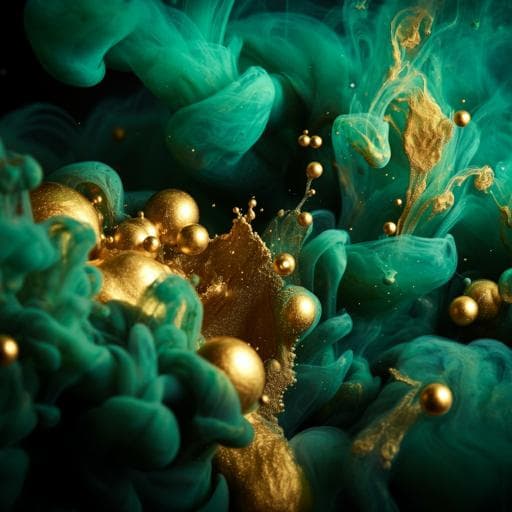
Food Science and Technology
Effects of phenolic acids and quercetin-3-O-rutinoside on the bitterness and astringency of green tea infusion
Y. Chen, Y. Zhang, et al.
This fascinating study conducted by Yu-Hong Chen and colleagues reveals how phenolic acids and quercetin-3-O-rutinoside interact to influence the bitterness and astringency of green tea. Chemical analyses and sensory evaluations highlight the significant taste characteristics of these compounds, showcasing their role in enhancing the overall flavor profile of this beloved beverage. Uncover the complexities of taste in green tea that go beyond just caffeine!
~3 min • Beginner • English
Introduction
Green tea is widely consumed and appreciated for health benefits and complex taste, notably bitterness and astringency. Polyphenols, especially catechins, are key contributors to these attributes, with galloylated catechins strongly linked to bitterness and astringency. Phenolic acids (e.g., gallic acid, chlorogenic acid, caffeic acid) and flavonol glycosides (e.g., quercetin-3-O-rutinoside, Que-rut) also contribute, with prior work indicating sour/astringent qualities and positive correlations with taste intensity in teas. Given that green tea is a complex mixture where taste-active compounds interact (synergistically, additively, or inhibitory), the study aims to elucidate how phenolic acids and Que-rut contribute to and modulate bitterness and astringency in green tea infusions and in combination with EGCG, addressing a gap in systematic sensory evaluation of these compounds in green tea.
Literature Review
Prior studies show: (1) Catechins represent 70–80% of tea polyphenols, with galloylated catechins (e.g., EGCG, ECG) highly correlated with bitterness and astringency in green tea. (2) Phenolic acids (GA, CGA, CA) impart sourness and astringency; GA and CGA correlate with bitterness/astringency in white tea; GA strongly affects astringency. (3) Flavonol glycosides like Que-rut contribute notably to astringency (velvety, soft) and are major contributors in black tea. (4) Taste interactions are common: EGCG can enhance bitterness/astringency of caffeine and suppress sucrose sweetness; GA can lower astringency of alum; Que-rut can increase caffeine bitterness. However, detailed sensory evaluation of phenolic acids and Que-rut in green tea and their interaction effects on green tea bitterness/astringency had been limited.
Methodology
Design: Combined chemical analyses and sensory evaluation to quantify contributions of phenolic acids and Que-rut to bitterness and astringency in green tea, and to analyze taste interactions with EGCG and with tea infusions.
Samples: Sixteen green tea samples (one bud and one leaf) harvested in 2017 from the National Tea Tree Resource Nursery (Hangzhou, China), processed by fixing, rolling, and drying (baking process). Infusions prepared by brewing 3.0 g tea with 150 mL boiling water for 4 min (GB/T 23776-2018). Infusions cooled to 25 °C before evaluation and chemical analysis.
Chemicals: Standards of catechins (C, GC, CG, GCG, EC, EGC, ECG, EGCG), flavonols (Kae, Kae-rut, Kae-glu, Que, Que-rha, Que-rut, Que-glu, Que-gala, Myr-rha, Myr-gala, Vit, Vit-rha), and phenolic acids (GA, CGA, CA) from Sigma-Aldrich (China). Reagents and solvents from commercial suppliers; pure water (pH 6.82±0.03; conductivity 1.84±0.13 µS/cm).
Sensory panel: Five trained panelists (3 men, 2 women; 25–48 years; Tea Research Institute CAAS). Ethics approved (Zhejiang Gongshang University Human Ethics Committee, No. 2020-12); written consent obtained. Evaluations conducted at 25 °C, ~75% RH. Panel trained to anchor intensity using EGCG solutions. Ten-point scale: 0–2 (not), 2–4 (slightly), 4–6 (moderately), 6–8 (very), 8–10 (extremely) bitter/astringent. Procedure: sip ~15 mL, evaluate bitterness during 7–8 s oral holding; expectorate; evaluate astringency over 3–4 s; 5-min interval with palate rinse. Each assessment repeated three times on different days; report mean ± SD.
Chemical analyses: Total tea polyphenols (GB/T 21733-2008) and total catechins (GB/T 8313-2018). Flavonols quantified by HPLC (Shimadzu LC-2010A; Symmetry C18, 250×4.6 mm, 5 µm; UV 360 nm; 20 µL injection; 1 mL/min; 25 °C; acetonitrile/formic acid/water gradient). Phenolic acids quantified by UPLC-QE-Orbitrap-MS (ACQUITY UPLC HSS T3, 1.8 µm, 2.1×100 mm; mobile phases 0.1% formic acid in water and acetonitrile; 0.3 mL/min; 40 °C; specified gradient; negative ESI full scan; resolution 70,000 full MS; ddMS2 35,000; m/z 66.7–1000; external calibration with standards).
Concentration–intensity curves: Prepared solutions of CA and CGA (0–0.3 mmol/L), GA (0–1.0 mmol/L), Que-rut (0–0.2 mmol/L); evaluated bitterness and astringency; fit cubic psychophysical models (y = taste intensity; x = concentration in mmol/L).
Taste interaction tests with EGCG: (a) Binary mixtures: 5 EGCG concentrations (0.2–1.0 mmol/L), combined 1:1 with GA (1.0 mmol/L; astringency 1.8), CGA (0.2 mmol/L; 1.0), CA (0.2 mmol/L; 1.5), Que-rut (0.05 mmol/L; 0.5). Compared mixed actual scores vs theoretical sums of components to infer inhibition vs synergy. (b) Fixed EGCG at 1.0 mmol/L (bitterness 2.4; astringency 3.0) with graded GA (0–1.0), CGA (0–0.3), CA (0–0.3), Que-rut (0–0.2) mmol/L; evaluated interaction effects.
Taste interaction tests with tea infusions: Brewed base infusions (1:50 w/v, 100 °C, 4 min), diluted 1:2 to 1:6, split into control and interaction groups. Mixed with GA (0.1 mmol/L; astringency 0.2), CGA (0.015 mmol/L; 0.2), CA (0.002 mmol/L; 0.1), Que-rut (0.05 mmol/L; 0.5). Also, at fixed tea infusion (diluted 1:2; 0.16 °Brix), combined with graded GA (0–0.2), CGA (0–0.1), CA (0–0.1), Que-rut (0–0.2) mmol/L to assess concentration-dependent interactions.
Dose-over-threshold (Dot) analysis: Calculated contribution ratios (Dot factors) for bitterness/astringency using measured concentrations and literature taste thresholds to identify key contributors.
Statistics: Mean ± SD of triplicates; one-way ANOVA (SPSS v22.0); significance at p < 0.05.
Key Findings
- Sensory ranges and association: Across 16 green tea infusions, bitterness ranged 3.00 ± 0.07 to 6.03 ± 0.04 (mean 4.59), astringency 2.95 ± 0.07 to 6.00 ± 0.00 (mean 4.58), with a strong correlation between bitterness and astringency (r = 0.931, p < 0.01).
- Correlations with polyphenols (Table 1):
• Total tea polyphenols correlated with bitterness (r = 0.947, p < 0.01) and astringency (r = 0.938, p < 0.01).
• Total catechins: bitterness r = 0.881**; astringency r = 0.904**.
• Key catechins: EGCG (bitterness r = 0.922**, astringency r = 0.895**), ECG (0.820**, 0.853**), GCG (0.774**, 0.746**), CG (0.762**, 0.695**).
• Flavonoids: total flavonoids correlated (bitterness r = 0.534*, astringency r = 0.651**); Kae (0.734**, 0.803**); Vit-rha (0.708**, 0.651**); Que-rut (0.605*, 0.576*).
• Phenolic acids: total phenolic acids correlated (bitterness r = 0.757**, astringency r = 0.870**); GA (0.671**, 0.634**); CGA (0.441 [ns] bitterness, 0.644** astringency); CA negative and not significant.
- Dot (Dose-over-threshold) analysis (Table 2): Major contributors to bitterness were ECG and EGCG. Major contributors to astringency were EGC, ECG, EGCG, and several flavonols (Kae-rut, Kae-glu, Que-rut, Que-glu, Que-gala, Myr-gala). Flavonols were dominant contributors to astringency; Que-rut had the highest Dot factor for astringency (average 4113.99). Despite strong sour/astringent taste qualities, GA, CGA, and especially CA had low Dot factors due to low infusion concentrations.
- Concentration–intensity functions: CA, CGA, and GA were primarily sour/astringent with negligible bitterness; Que-rut had mild astringency. At 0.2 mmol/L, astringency ranked CA > CGA > Que-rut > GA. Astringency curves for CA, CGA, GA, and Que-rut followed S-shaped psychophysical relationships well fit by cubic functions with R^2 > 0.998.
- Interactions with EGCG (Fig. 2):
• Bitterness: GA (1.0 mM), CGA (0.2 mM), CA (0.2 mM), and Que-rut (0.05 mM) significantly enhanced EGCG bitterness; enhancement increased with co-solute concentration.
• Astringency: GA consistently enhanced EGCG astringency across all tested concentrations. CA, CGA, and Que-rut showed concentration-dependent dual effects: inhibition at lower concentrations (CA 0–0.2 mM; CGA 0–0.2 mM; Que-rut 0–0.05 mM) and enhancement at higher concentrations.
- Interactions with green tea infusion (Fig. 3): GA, CGA, and CA showed synergistic enhancement of both bitterness and astringency; Que-rut produced synergy for bitterness and a superimposed (additive) effect on astringency at 0–0.05 mM, and synergy for both above 0.05 mM. Synergistic effects increased with increasing concentrations of the added phenolics/Que-rut.
- Overall: Phenolic acids and Que-rut, especially GA and Que-rut, contribute substantially to astringency and can modulate bitterness/astringency through synergistic interactions, helping explain why astringency cannot be fully accounted for by catechin concentration alone.
Discussion
The study demonstrates that beyond catechins, phenolic acids and Que-rut significantly influence the sensory profile of green tea, particularly astringency. Strong correlations of total phenolic acids and Que-rut with bitterness and astringency, along with high Dot factors for flavonols (notably Que-rut), indicate these components are major astringency drivers. Psychophysical modeling confirms their modest intrinsic astringency within studied ranges, but interaction studies reveal substantial modulation of EGCG and tea infusion taste: GA consistently enhances astringency, while CA, CGA, and Que-rut shift from inhibitory (at low concentrations) to synergistic (at higher concentrations) effects on EGCG astringency. In real tea infusions, all four compounds synergistically enhance bitterness and astringency, with synergy strengthening as concentration increases, suggesting multicomponent matrices amplify taste perception, possibly via mixture-induced threshold reductions or interactions with additional taste-active constituents. These results address the research question by identifying specific phenolic contributors and quantifying their interaction dynamics, underscoring that astringency cannot be predicted solely from catechin levels and that phenolic acids and flavonol glycosides are critical modulators of green tea taste.
Conclusion
Phenolic acids (GA, CGA, CA) and quercetin-3-O-rutinoside (Que-rut) are significantly positively associated with bitterness and astringency in green tea infusions. While phenolic acids are mainly sour/astringent and Que-rut mildly astringent, all studied compounds increase EGCG bitterness; GA uniformly enhances EGCG astringency, whereas CA, CGA, and Que-rut show concentration-dependent inhibition-to-synergy transitions. In green tea infusions, these compounds synergistically enhance bitterness and astringency, with synergy intensifying with concentration. Flavonols, especially Que-rut, contribute prominently to astringency. These insights refine the chemical basis of green tea taste and can inform strategies to modulate bitterness and astringency in tea and tea-based beverages. Future research should map broader interaction networks among multiple taste-active compounds in tea, quantify matrix effects on sensory thresholds, and explore processing or formulation approaches to optimize taste profiles.
Limitations
- Sensory evaluation used a small, trained panel (n=5), which may limit generalizability to broader consumer populations.
- Only three phenolic acids (GA, CGA, CA) and one flavonol glycoside (Que-rut) were evaluated in depth; other phenolics and non-phenolic constituents may also contribute or interact.
- Concentration ranges tested, while relevant, may not cover the full spectrum present across diverse green teas or preparation methods.
- Interaction analyses focused on binary mixtures with EGCG and additions to tea infusion; higher-order interactions in the full matrix were not exhaustively characterized.
- Dot analyses rely on literature thresholds that can vary with matrix conditions, potentially affecting contribution estimates.
Related Publications
Explore these studies to deepen your understanding of the subject.







